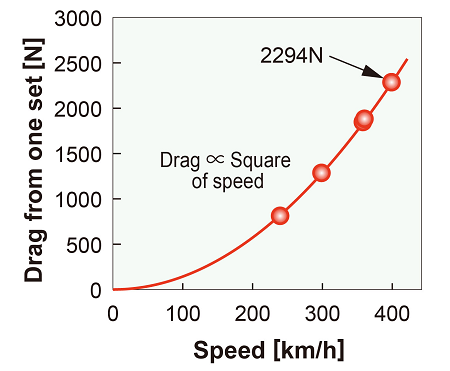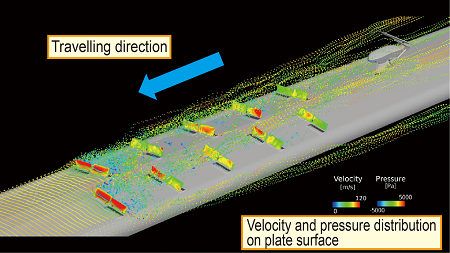22. Aerodynamic brake design for higher Shinkansen running speeds
Reducing the stopping distance of Shinkansen trains to improve safety has always been an important topic. In the case of rain or snow in particular, or conditions that reduce wheel/rail adhesion (friction force), a new type of aerodynamic brake has been developed which can complement the braking force in emergencies, such as during an earthquake, etc.
The device works by increasing the aerodynamic resistance acting on a running train when necessary, thereby directly reducing the speed of the vehicle with a braking method which does not rely on adhesion. This braking system has the specificity that it generates sufficient aerodynamic resistance when in use, but is folded back into the passenger vehicles at other times, in order to avoid affecting normal operation.
The developed device is composed of one set of two drag plates, which are designed to stay up alone without extra support by virtue of differences between the aerodynamic forces of travelling winds generated when the train is running: the assembly is 65 mm thick, with a mass of 36 kg, and is therefore both lightweight and compact (Fig.1).
A prototype was tested in a wind tunnel with a wind speed of 400 km/h. The maximum resistance force of 2.3 kN (3.5 kN in tunnels) on each set could be obtained within 0.3 seconds after sending the operation command (Fig. 2). The durability of the device was tested by deploying the wings continuously in a speed of 400 km/h over a long period of time (cumulative total of 4 hours of wind blowing), and no problems were observed, while the tests also confirmed that no aerodynamic noise was generated when the wings were stored. Verifications were also made to confirm the operational safety of the device in low and freezing temperatures, and in case of a bird strike, etc.
A computational fluid dynamics (CFD) analysis was carried out by mounting the device on the roof of a 10-car trainset (Fig. 3).
After adjusting the location of the device on the roof to achieve maximum drag on the whole trainset, it was demonstrated that the device had the potential of reducing the stopping distance by approximately 10% with a running speed of over 360 km/h.
Other Contents
- 21. Vertical vibration control method for Shinkansen rolling stock
- 22. Aerodynamic brake design for higher Shinkansen running speeds
- 23. Method for increasing braking force of linear rail brakes
- 24. Development of a CPS contact wire for Shinkansen
- 25. Yield management method optimizing discount ticket sales quota
- 21. Vertical vibration control method for Shinkansen rolling stock
- 22. Aerodynamic brake design for higher Shinkansen running speeds
- 23. Method for increasing braking force of linear rail brakes
- 24. Development of a CPS contact wire for Shinkansen
- 25. Yield management method optimizing discount ticket sales quota



